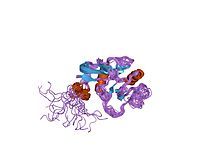| Link domain | |||||||||
|---|---|---|---|---|---|---|---|---|---|
 Structure of the hyaluronan-binding domain of human CD44 Structure of the hyaluronan-binding domain of human CD44 | |||||||||
| Identifiers | |||||||||
| Symbol | LINK | ||||||||
| Pfam | PF00193 | ||||||||
| Pfam clan | CL0056 | ||||||||
| InterPro | IPR000538 | ||||||||
| SMART | SM00445 | ||||||||
| PROSITE | PDOC00955 | ||||||||
| SCOP2 | 1o7b / SCOPe / SUPFAM | ||||||||
| CDD | cd01102 | ||||||||
| |||||||||
A Link domain or Link module, also known as Xlink domain (X for extracellular), is a protein domain that binds to hyaluronic acid. It is important in blood cell migration and apoptosis. The link domain is found in some extracellular proteins in vertebrates such as the hyalectans. It appears to be involved in extracellular matrix assembly and stability, cell adhesion, and migration.
Structure
The structure has been shown to consist of two alpha helices and two antiparallel beta sheets arranged around a large hydrophobic core similar to that of C-type lectin. This domain contains four conserved cysteines involved in two disulphide bonds. The link domain has also been termed HABM (hyaluronic acid binding module) and PTR (proteoglycan tandem repeat).
Link domain proteins
Proteins which contain the link domain include:
- the hyalectans (a family of proteoglycans): aggrecan, brevican, neurocan and versican, which are expressed in the CNS;
- the cartilage link protein (LP), a proteoglycan that together with HA and aggrecan forms multimolecular aggregates;
- Tumour necrosis factor-inducible protein 6 (TSG-6), which may be involved in cell-cell and cell-matrix interactions during inflammation and tumourigenesis;
- CD44 antigen, the main cell surface receptor for HA.
See also
References
- "Link domain signature and profile". PROSITE. December 2004. Retrieved 30 September 2016.
- Yoneda M, Nakamura T, Murai M, Wada H (2010). "Evidence for the heparin-binding ability of the ascidian Xlink domain and insight into the evolution of the Xlink domain in chordates". J Mol Evol. 71 (1): 51–9. Bibcode:2010JMolE..71...51Y. doi:10.1007/s00239-010-9363-x. PMID 20582409. S2CID 10614265.
- ^ Hynes, RO; Naba, A (21 September 2011). "Overview of the Matrisome--An Inventory of Extracellular Matrix Constituents and Functions". Cold Spring Harbor Perspectives in Biology. 4 (1): a004903. doi:10.1101/cshperspect.a004903. PMC 3249625. PMID 21937732.
- ^ Barta E, Deák F, Kiss I (June 1993). "Evolution of the hyaluronan-binding module of link protein". Biochem. J. 292 (3): 947–9. doi:10.1042/bj2920947. PMC 1134205. PMID 8318021.
- Kohda D, Morton CJ, Parkar AA, Hatanaka H, Inagaki FM, Campbell ID, Day AJ (September 1996). "Solution structure of the link module: a hyaluronan-binding domain involved in extracellular matrix stability and cell migration". Cell. 86 (5): 767–75. doi:10.1016/S0092-8674(00)80151-8. PMID 8797823. S2CID 16347386.
- Brissett NC, Perkins SJ (June 1996). "The protein fold of the hyaluronate-binding proteoglycan tandem repeat domain of link protein, aggrecan and CD44 is similar to that of the C-type lectin superfamily". FEBS Lett. 388 (2–3): 211–6. doi:10.1016/0014-5793(96)00576-5. PMID 8690089. S2CID 24295651.